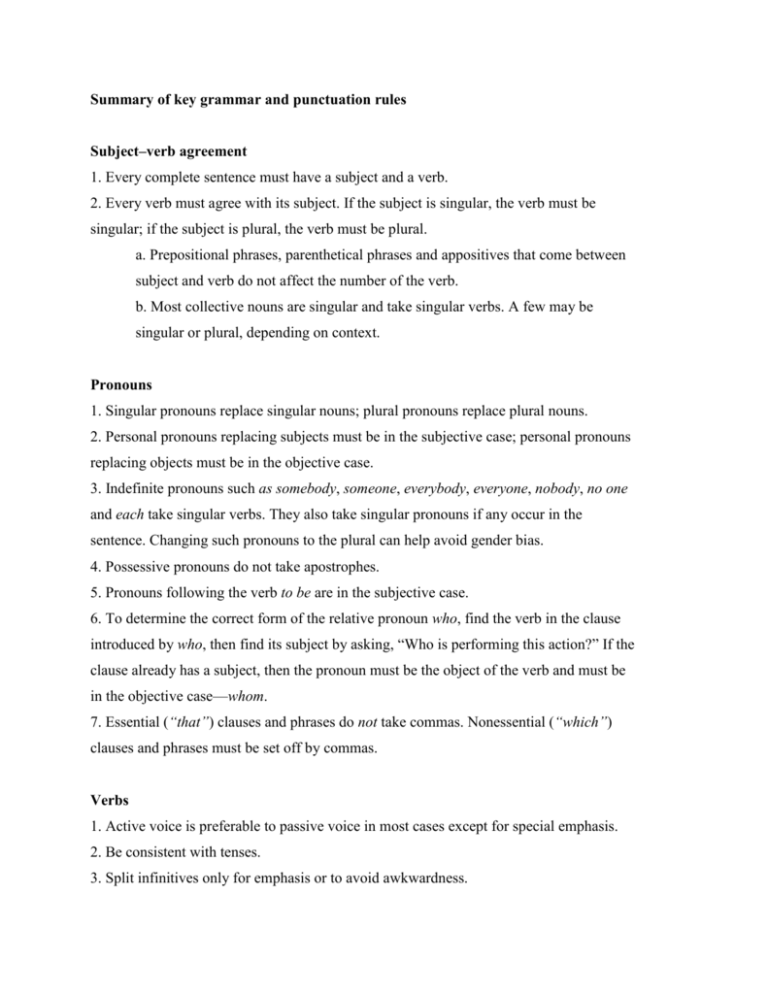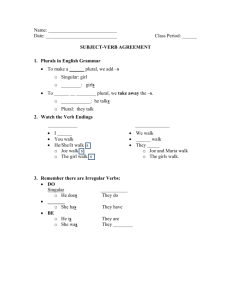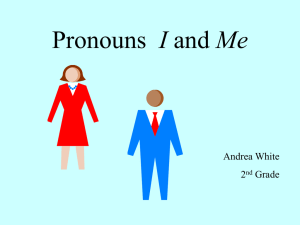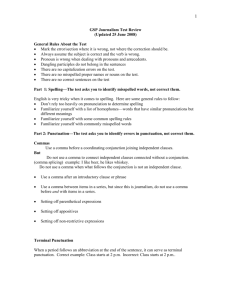Summary of key grammar and punctuation rules
advertisement

Summary of key grammar and punctuation rules Subject–verb agreement 1. Every complete sentence must have a subject and a verb. 2. Every verb must agree with its subject. If the subject is singular, the verb must be singular; if the subject is plural, the verb must be plural. a. Prepositional phrases, parenthetical phrases and appositives that come between subject and verb do not affect the number of the verb. b. Most collective nouns are singular and take singular verbs. A few may be singular or plural, depending on context. Pronouns 1. Singular pronouns replace singular nouns; plural pronouns replace plural nouns. 2. Personal pronouns replacing subjects must be in the subjective case; personal pronouns replacing objects must be in the objective case. 3. Indefinite pronouns such as somebody, someone, everybody, everyone, nobody, no one and each take singular verbs. They also take singular pronouns if any occur in the sentence. Changing such pronouns to the plural can help avoid gender bias. 4. Possessive pronouns do not take apostrophes. 5. Pronouns following the verb to be are in the subjective case. 6. To determine the correct form of the relative pronoun who, find the verb in the clause introduced by who, then find its subject by asking, “Who is performing this action?” If the clause already has a subject, then the pronoun must be the object of the verb and must be in the objective case—whom. 7. Essential (“that”) clauses and phrases do not take commas. Nonessential (“which”) clauses and phrases must be set off by commas. Verbs 1. Active voice is preferable to passive voice in most cases except for special emphasis. 2. Be consistent with tenses. 3. Split infinitives only for emphasis or to avoid awkwardness. 4. Use the possessive form when modifying gerunds. Adjectives and adverbs 1. When a compound adjective comes before the noun it modifies; hyphenate for clarity if necessary. 2. Use adjectives and adverbs sparingly. Make strong, specific nouns and verbs do most of the work. Punctuation 1. Do not punctuate unless you know a rule. When in doubt, leave it out. 2. Use a comma before the conjunction in a compound sentence if the clause that follows has an explicit subject. 3. Omit the final comma in a simple series. 4. Use a comma between equal adjectives. 5. Use commas to set off nonessential and introductory phrases and clauses. 6. Use commas to set off ages, state names that follow city names in addresses, and years that follow specific dates. 7. Use a comma to separate attribution from complete quotations or paraphrases. 8. Commas and period always go inside closing quotation marks. 9. Use double quotation marks around the exact words of a speaker. Use single quotation marks around quotes within quotes. 10. Use colons before formal lists, tabulations, long quotations or to give emphasis. 11. Use a hyphen between a prefix and the word it modifies when the last letter of the prefix and the first letter of the modified word are the same. 12. Use dashes sparingly for abrupt changes in thought or for dramatic pauses. 13. Keep parentheses, slashes and exclamation marks to an absolute minimum in news copy.











